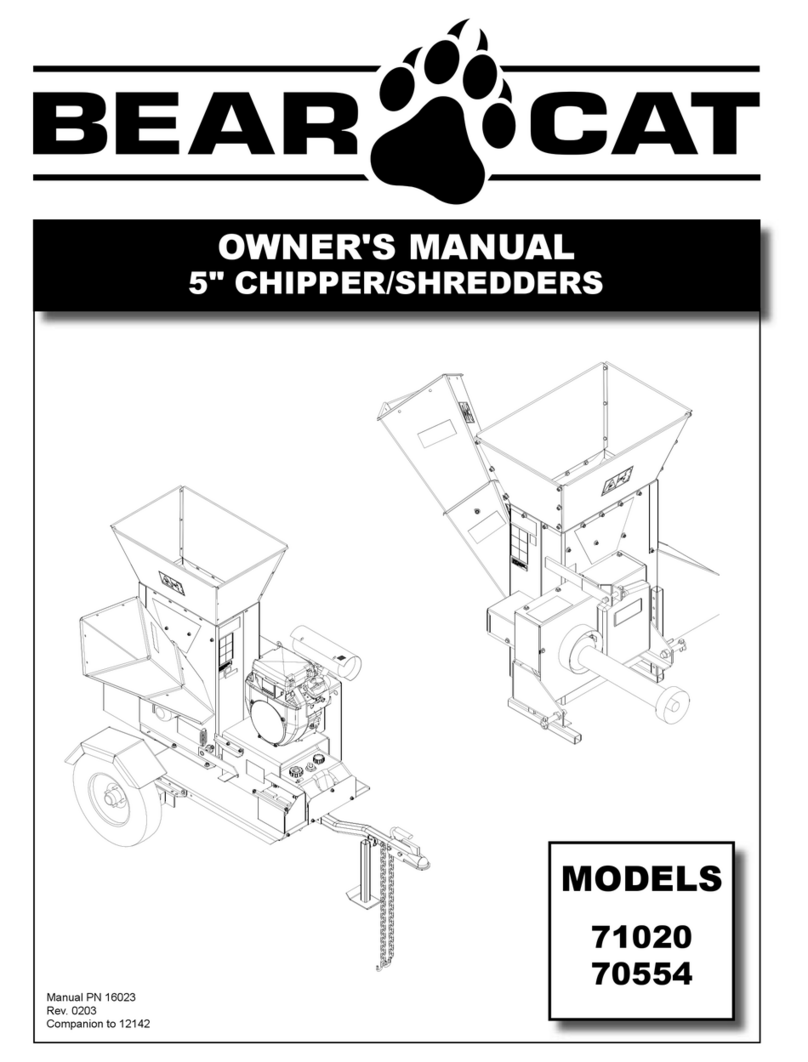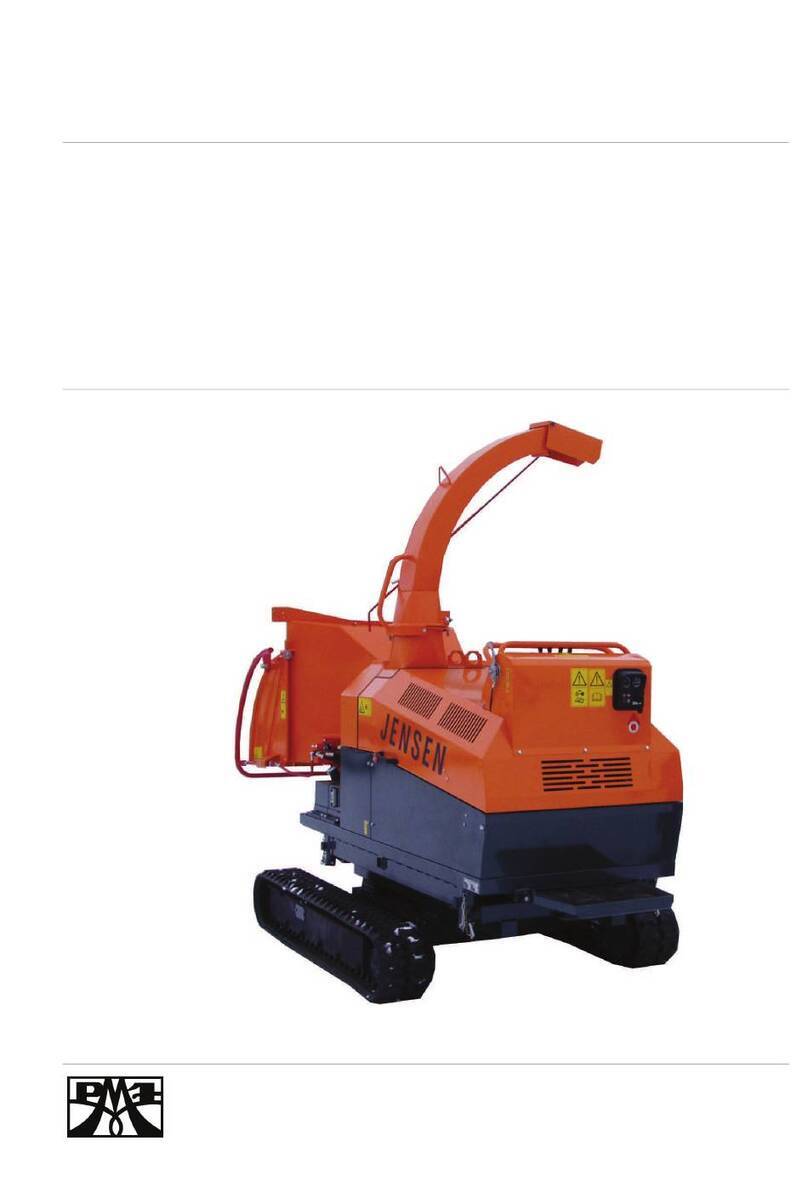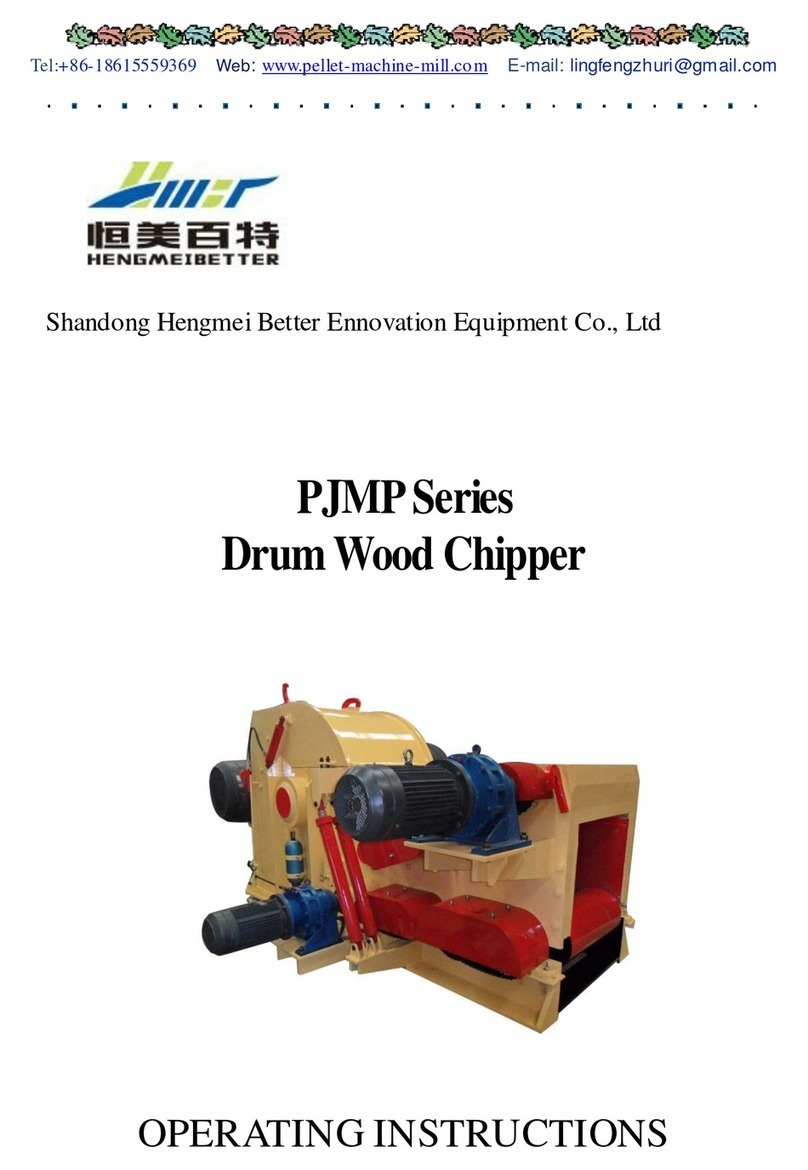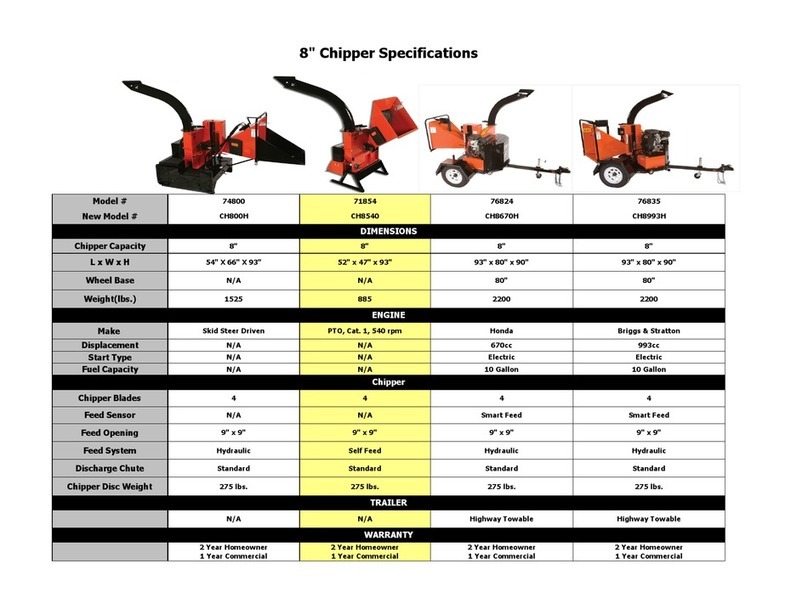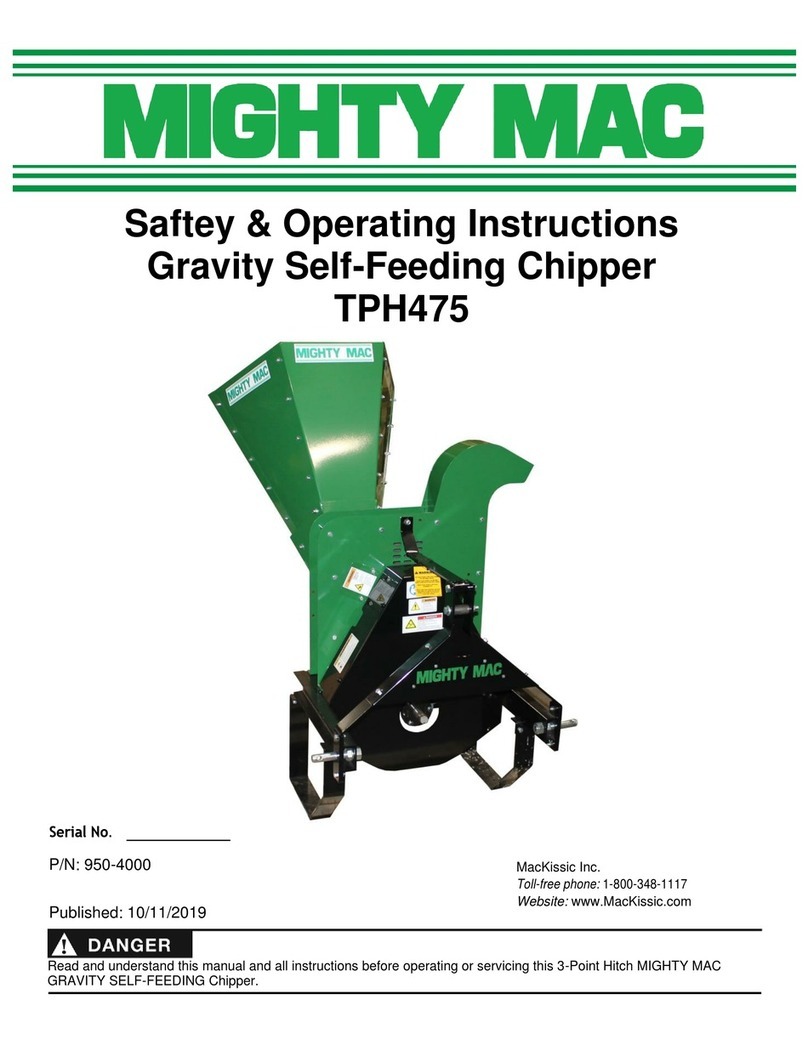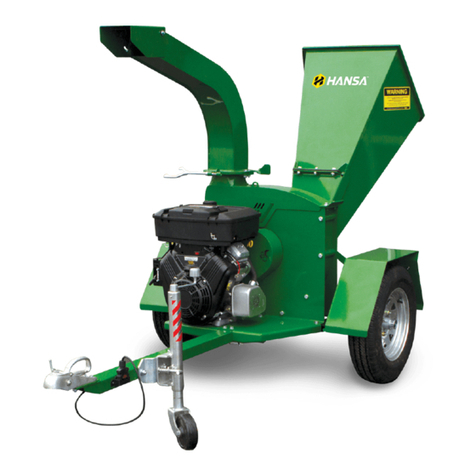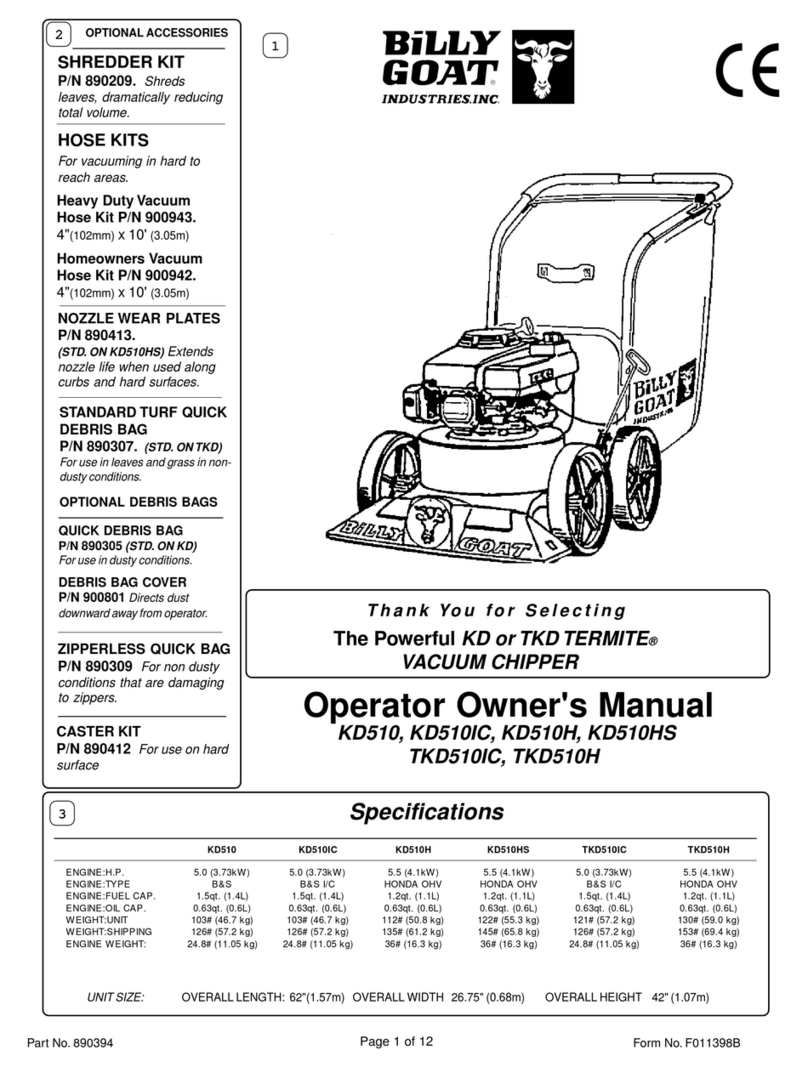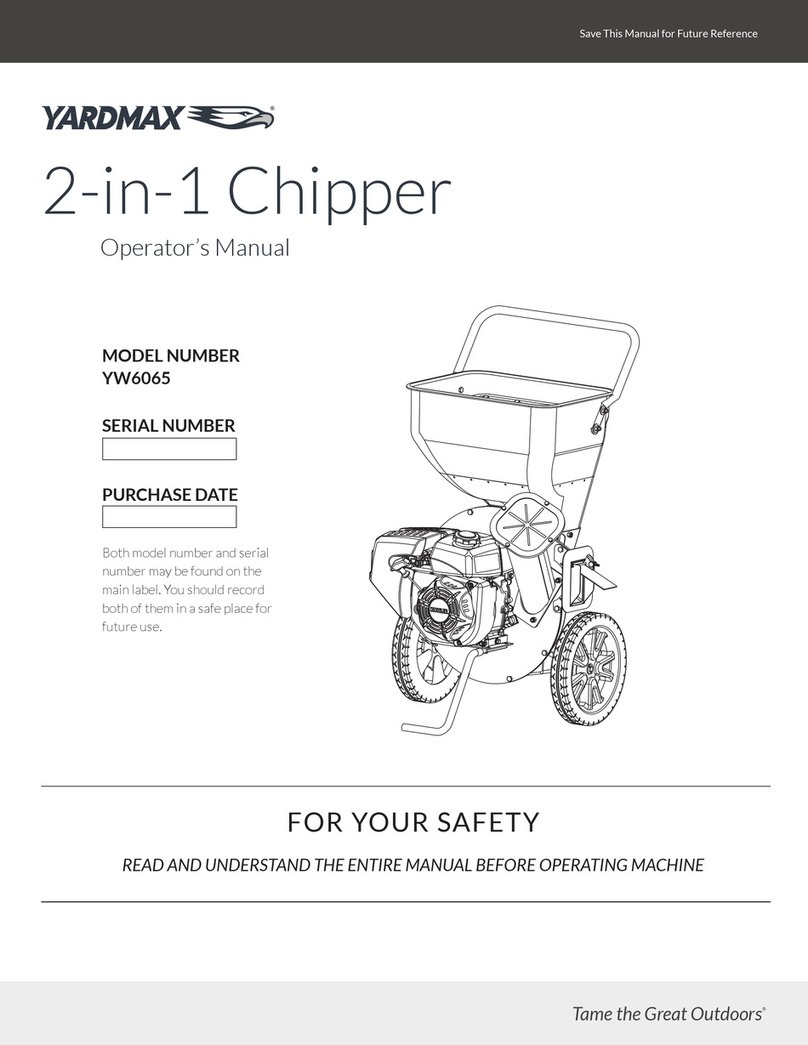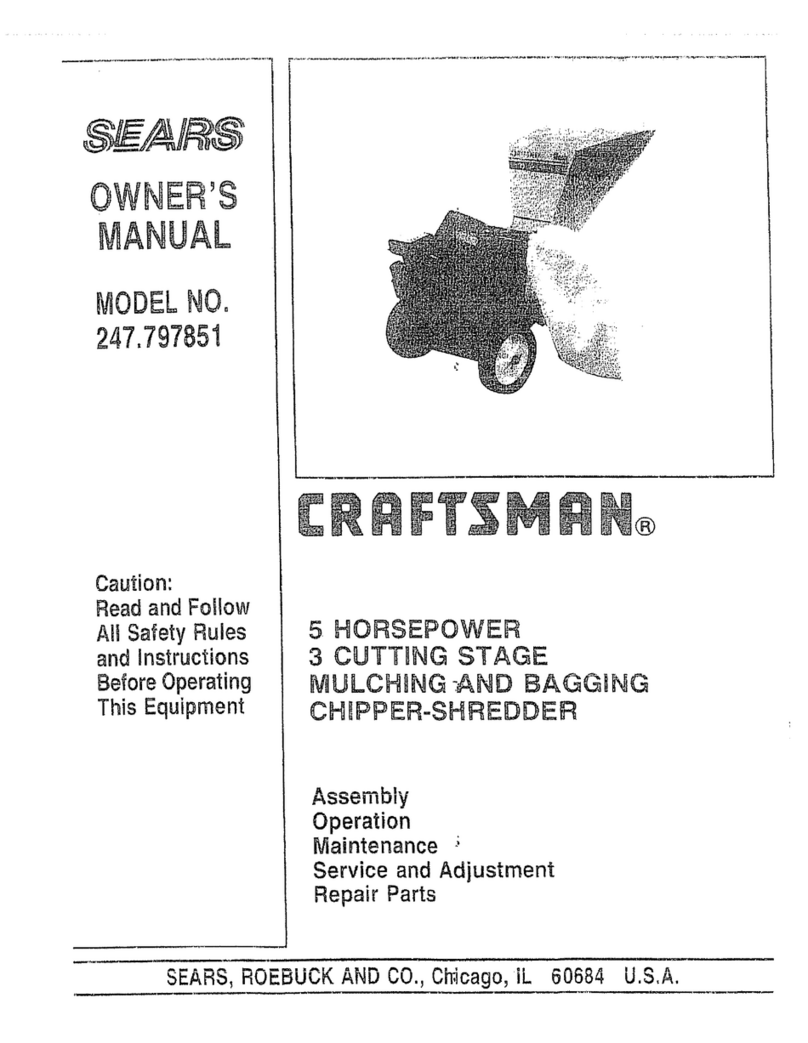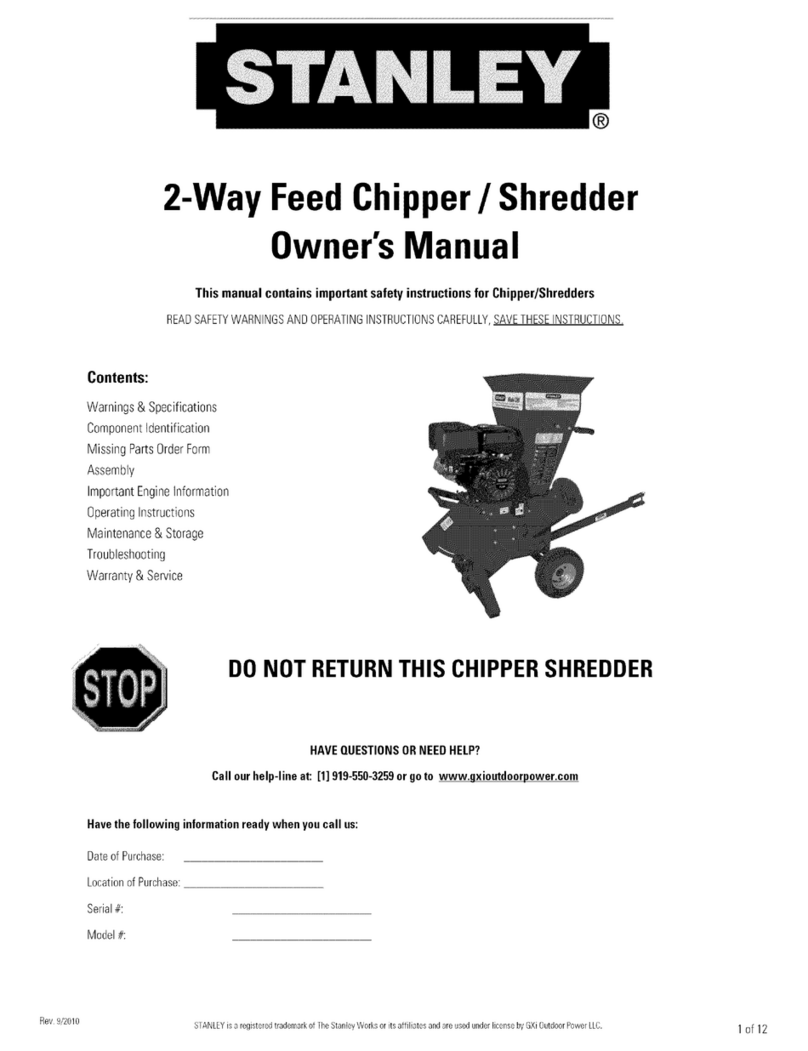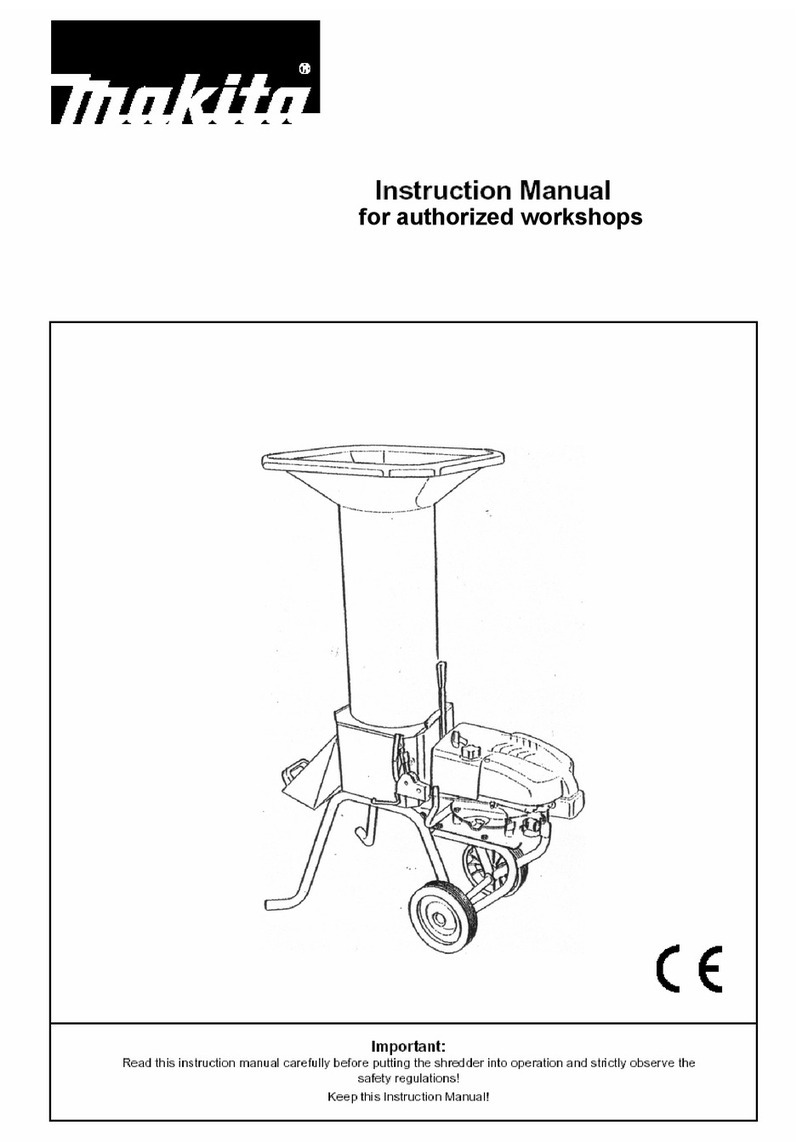Bearcat CH4420 User manual

OWNER'S MANUAL
ENGLISH
PN: 73311-00
Rev. 051117
Companion to 73317-00
Range: 5VJAA0112HW005438 - Current
CH4420 – 420cc BRIGGS & STRATTON
4 INCH CHIPPER
www.bearcatproducts.com

Before You Begin
DEAR ECHO BEAR CAT CUSTOMER
Thank you for purchasing a ECHO Bear Cat product. The ECHO Bear Cat line is designed, tested, and manufactured
to give years of dependable performance. To keep your machine operating at peak eciency, it is necessary to adjust
it correctly and make regular inspections. The following pages will assist you in the operation and maintenance of your
machine. Please read and understand this manual before operating your machine.
If you have any questions or comments about this manual, please call us toll-free at 1.888.645.4520.
If you have any questions or problems with your machine, please call or write your local authorized ECHO Bear Cat
Dealer.
This document is based on information available at the time of its publication. ECHO Bear Cat is continually making
improvements and developing new equipment. In doing so, we reserve the right to make changes or add improvements
to our product without obligation for equipment previously sold.
PLEASE SEND US YOUR WARRANTY CARD
A warranty card is included in your owner's kit packaged with your machine. Please take the time to ll in the information
requested on the card. When you send your completed card to us, we will register your machine and start your coverage
under our limited warranty or go to bearcatproducts.com/warranty/warranty-registration/.
SERIAL NUMBER OR VIN
© 2017, CRARY INDUSTRIES, ALL RIGHTS RESERVED. PRODUCED AND PRINTED IN THE U.S.A.
IDENTIFICATION NUMBER LOCATION
Your machine will have either a serial number or vehicle
identication number (VIN). VINs are located on the left
side of the trailer frame near the hitch. They are 17-digit
numbers of the format: 5VJAA001XXWXXXXX. Serial
numbers are located on the machine body. They are
6-digit numbers.
Record your identication number in the space provided
and on the warranty registration card.
FOR MACHINE SERVICE OR PARTS:
For service assistance, contact your nearest authorized
ECHO Bear Cat dealer or the factory. For parts, contact
your authorized dealer. Your dealer will need to know the
serial number of your machine to provide the most ecient
service. See below for information on how to identify and
record the serial number for your machine.
FOR ENGINE SERVICE OR PARTS:
For engine service or parts, contact your nearest
authorized engine dealer. ECHO Bear Cat does not
handle any parts, repairs or warranties for engines.
ORDERING PARTS
Only genuine ECHO Bear Cat replacement parts should
be used to repair the machine. Replacement parts
manufactured by others could present safety hazards,
even though they may t on this machine. Replacement
parts are available from your ECHO Bear Cat dealer.
Provide the following when ordering parts:
The SERIAL NUMBER or VIN of your machine.
The PART NUMBER of the part.
The PART DESCRIPTION.
The QUANTITY needed.
HOW TO CONTACT ECHO BEAR CAT
ADDRESS PHONE E-MAIL HOURS
237 NW 12th Street
P.O. Box 849
West Fargo, ND 58078
888.625.4520
701.282.5520
Fax: 701.282.9522
Monday - Friday,
8 a.m. to 5 p.m.
Central Time

LIMITED WARRANTY
This warranty applies to all ECHO Bear Cat Outdoor Power Equipment manufactured by Crary Industries, Inc.
and does not include gas engine or electric powered pressure washers under the ECHO Bear Cat brand. See
ECHO Bear Cat Pressure Washer Limited Warranty for complete warranty details on those products.
Crary Industries, Inc. warrants to the original owner each new ECHO Bear Cat product to be free from defects
in material and workmanship, under normal use and service. The warranty shall extend, from date of purchase,
3 years (U.S. and Canada only (2 years outside U.S. and Canada)) for Consumer use of the product, 1 year
for Commercial applications and 6 months for Rental applications. Replacement parts and accessories are
warranted for (90) days from date of installation. Batteries for Inverters and Generators are warranted for ninety
(90) days from the date of purchase.
"Consumer" dened as: complete unit for personal, residential or non-income producing use.
"Commercial" dened as: complete unit for commercial, institutional, property management, agricultural,
horticultural or income producing use.
"Rental" dened as: complete unit for rental purposes to produce income.
*Models SC2163, SC2170 & SC3206 are classied as Consumer grade products and will not qualify for
warranty coverage if used for Commercial or Rental purposes.
The product is warranted to the original owner by either a completed warranty registration on le at Crary
Industries, Inc. and/or proof of sale. Warranty coverage begins on the date of purchase. The warranty
registration can be registered on-line by visiting http://bearcatproducts.com/warranty/warrantyregistration/ or
the paper card completed and returned to Crary Industries, Inc.
In the event of a failure, return the product, at your cost, along with proof of purchase to the selling ECHO Bear
Cat dealer. Crary Industries, Inc. will, at its option, repair or replace any parts found to be defective in material
or workmanship. Warranty on any repairs will not extend beyond the product warranty. Repair or attempted
repair by anyone other than an authorized ECHO Bear Cat dealer as well as subsequent failure or damage that
may occur as a result of that work will not be paid under this warranty. Crary Industries, Inc. does not warrant
replacement components not manufactured or sold by Crary Industries, Inc.
1. This warranty applies only to parts or components that are defective in material or workmanship.
2. This warranty does not cover normal wear items including, but not limited to: batteries, bearings, belts,
pulleys, lters, chipper blades, shredder ails or knives.
3. This warranty does not cover normal maintenance, service or adjustments.
4. This warranty does not cover depreciation or damage due to misuse, negligence, accident or improper
maintenance.
5. This warranty does not cover damage due to improper setup, installation or adjustment.
6. This warranty does not cover damage due to unauthorized modications of the product.
7. Engines are warranted by the respective engine manufacturer and are not covered by this warranty.
Crary Industries, Inc. is not liable for any property damage, personal injury or death resulting from the
unauthorized modication or alteration of an ECHO Bear Cat product or from the owner's failure to assemble,
install, maintain or operate the product in accordance with the provisions of the Owner's manual.
Crary Industries, Inc. is not liable for indirect, incidental or consequential damages or injuries including but not
limited to loss of crops, loss of prots, rental of substitute equipment or other commercial loss.
This warranty gives you specic legal rights. You may have other rights that may vary from area to area.
Crary Industries, Inc. makes no warranties, representations or promises, expressed or implied as to the
performance of its products other than those set forth in this warranty. Neither the dealer nor any other person
has any authority to make any representations, warranties or promises on behalf of Crary Industries, Inc.
or to modify the terms or limitations of this warranty in any way. Crary Industries, Inc., at its discretion, may
periodically oer limited, written enhancements to this warranty.
CRARY INDUSTRIES, INC. RESERVES THE RIGHT TO CHANGE THE DESIGN AND/OR
SPECIFICATIONS OF ITS PRODUCTS AT ANY TIME WITHOUT OBLIGATION TO PREVIOUS
PURCHASERS OF ITS PRODUCTS.
ENGLISH

TABLE OF CONTENTS
1 SAFETY ................................................................................................................................................................... 1
1.1 SAFETY ALERT SYMBOL .................................................................................................................................................... 1
1.2 FIRE HAZARD INFORMATION............................................................................................................................................ 1
1.3 BEFORE OPERATING.......................................................................................................................................................... 2
1.4 OPERATION SAFETY........................................................................................................................................................... 2
1.5 MAINTENANCE/STORAGE SAFETY.................................................................................................................................. 3
1.6 TOWING SAFETY ................................................................................................................................................................. 3
1.7 SAFETY DECALS ................................................................................................................................................................. 4
1.8 SAFETY DECAL LOCATIONS ............................................................................................................................................. 5
2 ASSEMBLY.............................................................................................................................................................. 6
2.1 ASSEMBLY (NON-CE COMPLIANT) ................................................................................................................................... 6
2.2 ASSEMBLY (CE COMPLIANT)............................................................................................................................................. 7
2.3 OPTIONAL CONFIGURATION............................................................................................................................................. 8
2.4 ADD OIL TO ENGINE............................................................................................................................................................ 9
2.5 FILL THE FUEL TANK........................................................................................................................................................... 9
3 FEATURES & CONTROLS .................................................................................................................................. 10
4 OPERATION.......................................................................................................................................................... 12
4.1 STARTING ENGINE............................................................................................................................................................ 12
4.2 OPERATING THE CHIPPER.............................................................................................................................................. 12
4.3 CHIPPER OPERATION GUIDELINES .............................................................................................................................. 13
4.4 SLOWING AND STOPPING THE CHIPPER ROTOR AND ENGINE.............................................................................. 14
4.5 TOWING............................................................................................................................................................................... 14
5 SERVICE & MAINTENANCE............................................................................................................................... 15
5.1 MAINTENANCE SCHEDULE ............................................................................................................................................. 15
5.2 ROTOR LOCK ..................................................................................................................................................................... 16
5.3 CHIPPER BLADES MAINTENANCE................................................................................................................................. 16
5.4 REMOVING THE BLADES ................................................................................................................................................. 16
5.5 SHARPENING THE BLADES............................................................................................................................................. 17
5.6 INSTALLING THE BLADES................................................................................................................................................ 17
5.7 SETTING CHIPPER BLADE CLEARANCE ...................................................................................................................... 17
5.8 TRAILER MAINTENANCE TIPS ........................................................................................................................................ 18
5.9 CLEARING A PLUGGED ROTOR...................................................................................................................................... 18
5.10 DRIVE BELTS.................................................................................................................................................................... 19
5.11 ROTOR BEARINGS .......................................................................................................................................................... 20
5.12 CHANGE OIL ..................................................................................................................................................................... 21
5.13 LUBRICATION................................................................................................................................................................... 22
6 TROUBLESHOOTING.......................................................................................................................................... 23
7 SPECIFICATIONS ................................................................................................................................................ 25
7.1 BOLT TORQUE.................................................................................................................................................................... 26
8 OPTIONS............................................................................................................................................................... 27

14 INCH CHIPPER
ENGLISH
Section
1 SAFETY
Indicates an imminently hazardous situation that, if not
avoided, will result in death or serious injury.
DANGER
1.1 SAFETY ALERT SYMBOL
Indicates a potentially hazardous situation that, if not
avoided, could result in death or serious injury.
WARNING
Indicates a potentially hazardous situation that, if not
avoided, may result in minor or moderate injury.
CAUTION
The Owner/Operator's manual uses this symbol to alert
you of potential hazards. Whenever you see this symbol,
read and obey the safety message that follows it. Failure
to obey the safety message could result in personal injury,
death or property damage.
Federal, state, and local laws may prohibit the operation
of an internal combustion engine using hydrocarbon
fuels on any forest covered, brush
covered or grass covered land or on
land covered with grain, hay or other
ammable agricultural crops, without
an engine spark arrestor in continuous
eective working order.
The engine on your power equipment,
like most outdoor power equipment,
is an internal combustion engine that burns gasoline
or diesel fuel (hydrocarbons). If operating your power
equipment in aected areas, it must be equipped with a
spark arrestor in continuous eective working order. The
spark arrestor must be attached to the engine exhaust
system in such a manner that ames or heat from the
system will not ignite ammable material.
Failure of the owner/operator of the equipment to comply
with federal, state, and local laws may subject him or her
to nes and/or other penalties. Contact your local re
marshal or forest service for specic information about
which regulations apply in your area.
The standard muer installed on the engine is spark
arrestor capable. Spark arrestors require regular
maintenance. See the Service & Maintenance section of
this manual for more information.
Contact local re authorities for laws or regulations
regarding re prevention requirements.
1.2 FIRE HAZARD INFORMATION

24 INCH CHIPPER
SAFETY
14. Keep all guards, deectors, and shields in good
working condition.
15. Before inspecting or servicing any part of this machine,
shut o the machine and make sure all moving parts
have come to a complete stop. Disconnect the battery
and remove the ignition key where applicable.
16. Check that all screws, nuts, bolts, and other fasteners
are secured, tightened and in proper working condition
before starting the machine.
17. Do not transport or move machine while it is operating
or running.
1. Always stand clear of discharge area when operating
this machine. Keep face and body away from feed
and discharge openings.
2. Keep hands and feet out of feed and discharge
openings while machine is operating to avoid serious
personal injury. Stop and allow
machine to come to a complete
stop before clearing obstructions.
3. Set up your work site so you are
not endangering trac and the
public. Take great care to provide
adequate warnings.
4. Do not climb on machine when operating. Keep
proper balance and footing at all times.
5. Check cutting chamber to verify it is empty before
starting the machine.
6. The rotor will continue to rotate after being disengaged.
Shut o the machine and make sure all moving parts
have come to a complete stop before inspecting or
servicing any part of the machine. Disconnect the
battery and remove the ignition key if applicable.
7. Do not insert branches with a diameter larger than
the max chipper capacity into machine or machine
damage may occur.
8. When feeding material into machine, do not allow
metal, rocks, bottles, cans or any other foreign
material to be fed into the machine.
9. Ensure debris does not blow into trac, parked cars,
or pedestrians.
10. Keep the machine clear of debris and other
accumulations.
11. Do not allow processed material to build up in the
discharge area. This may prevent proper discharge
and can result in kickback of material through the
feed opening.
1.3 BEFORE OPERATING
1. Read and understand this owner's manual. Be
completely familiar with the controls and the proper
use of this equipment.
2. Familiarize yourself with all of the safety and
operating decals on this equipment and on any of its
attachments or accessories.
3. Keep safety decals clean and legible. Replace
missing or illegible safety decals.
4. Obtain and wear safety glasses
and use hearing protection at all
times when operating this machine.
5. Avoid wearing loose tted clothing.
Never operate this machine while wearing clothing
with drawstrings that could wrap around or get caught
in the machine.
6. Do not operate this machine
if you are under the inuence
of alcohol, medications, or
substances that can aect your
vision, balance or judgement. Do
not operate if tired or ill. You must
be in good health to operate this
machine safely.
7. Do not operate this equipment in the vicinity of
bystanders. Keep the area of operation clear of all
persons, particularly small children. It is recommended
that bystanders keep at least 50 feet (15 meters)
away from the area of operation.
8. Do not allow children to operate this equipment.
9. Use only in daylight or good articial light.
10. Do not run this equipment in an enclosed area. Engine
exhaust contains carbon monoxide gas, a deadly
poison that is odorless, colorless and tasteless.
Do not operate this equipment in or near buildings,
windows or air conditioners.
11. Always use an approved fuel container. Do not
remove gas cap or add fuel when engine is running.
Add fuel to a cool engine only.
12. Do not ll fuel tank indoors. Keep open ames, sparks,
smoking materials and other sources of combustion
away from fuel.
13. Do not operate machine without shields in place.
Failure to do so may cause serious injury or death.
1.4 OPERATION SAFETY

34 INCH CHIPPER
ENGLISH
SAFETY
1. Before inspecting, servicing, storing, or changing
an accessory, shut o the machine and make sure
all moving parts have come to a complete stop.
Disconnect the battery and remove the ignition key
where applicable.
2. Replace any missing or unreadable safety decals.
Refer to the safety decal section for part numbers.
3. Allow machine to cool before storing in an enclosure.
4. Store the machine out of reach of children and where
fuel vapors will not reach an open ame or spark.
5. Never store this machine with fuel in the fuel tank
inside a building where fumes may be ignited by
an open ame or spark. Ignition sources can be hot
water and space heaters, furnaces, clothes dryers,
stoves, electric motors, etc.
6. Drain the fuel and dispose of it in a safe manner for
storage periods of three months or more.
12. If the machine becomes clogged, the cutting
mechanism strikes any foreign object, or the machine
starts vibrating or making an unusual noise, shut o
machine immediately and make sure all moving parts
have come to a complete stop. Disconnect the battery
and remove the ignition key if applicable. After the
machine stops: A) Inspect for damage, B) Replace
or repair any damaged parts, and C) Check for and
tighten any loose parts.
13. On electric start models, disconnect cables from
battery before doing any inspection or service.
Remove key.
14. Check blade bolts for proper torque after every 8 hours
of operation. Check blades and rotate or resharpen
daily or as required to keep blades sharp. Failure
to do so may cause poor performance, damage or
personal injury and will void the machine warranty.
1. Connect hitch safety chains. Tighten trailer hitch
bolts. Do not attempt to tow the trailer if the vehicle is
not equipped with a 2" (50 mm) ball.
2. Do not exceed the maximum towing speed indicated
on tire sidewall. Inate tires to manufacturer's
specications as stated on the tire sidewall.
3. Optimum towing performance can be achieved by
maintaining a horizontal trailer hitch.
4. Check wheel lug bolts periodically to ensure they are
tight and secure.
5. Make sure the jack stand and the rear stabilizer
(where applicable) on the trailer are in the UP position
during towing. Place the jack stand on a level surface
and secure it in the DOWN position before using.
6. Never allow passengers to ride on the machine.
7. If applicable, shut o fuel supply when towing.
8. Towing laws may vary in dierent countries/regions/
states. It is recommended that you contact your local
motor vehicle department for any special regulations
that pertain to towing and know the laws of any
country/region/state you travel through.
1.5 MAINTENANCE/STORAGE SAFETY
1.6 TOWING SAFETY

44 INCH CHIPPER
SAFETY
1.7 SAFETY DECALS
Keep hands and feet out of inlet and discharge
openings while machine is operating to avoid serious
personal injury. Stop and allow machine to come to a
complete stop before clearing obstructions.
Read and understand this owner/operators
manual. Be completely familiar with the
controls and the proper use of this equipment
Obtain and wear safety glasses and use
hearing protection at all times when operating
this machine.
Before inspecting or servicing any part of this
machine, shut o power source, remove the
key, disconnect spark plug wire from spark
plug and make sure all moving parts have
come to a complete stop.
Do not operate this equipment in the
vicinity of bystanders. Do not allow children
to operate this equipment. Always stand
clear of discharge area when operating
this machine. Keep face and body away from discharge areas.
Do not operate machine without shields in place.
Failure to do so may cause serious injury or death.
Check blade bolts for proper torque
after every 8 hours of operation.
Check blades and rotate or
resharpen daily or as required to
keep blades sharp. Refer to owners
manual for instructions. Failure to do so may cause poor performance,
damage or personal injury and will void the machine warranty.
Read and understand you owners manual before operating. If owners
manual was not included or you have any questions, please call
800.247.7335 or 701.282.5520 (U.S.A.).
See Section 1.8 for decal locations. Familiarize yourself with all of the safety and operating decals on the machine
and the associated hazards. See the engine owner's manual or contact the engine manufacturer for engine safety
instructions and decals.
Keep hands and feet out of inlet and
discharge openings while machine is
operating to avoid serious personal injury.
Stop and allow machine to come to a complete stop before clearing
obstructions.
454 1000
5.30-12 550 kPa, 80 psi
1 6
27
3
4
8
5
PN 12169
PN 12172
PN 12173
PN 12174
PN 12175
PN 14942-00
PN 12250
PN 32161-00
Operation of this equipment may create
sparks that can start res around dry
vegetation. A spark arrestor may be
required. The operator should contact
local re agencies for laws or regulations
relating to re prevention requirements.
9PN 33883-00
33883-00
WARNING
ADVERTENCIA
OPERATION OF THIS EQUIPMENT MAY CREATE SPARKS
THAT CAN START FIRES AROUND DRY VEGETATION. A
SPARK ARRESTOR MAY BE REQUIRED. THE OPERATOR
SHOULD CONTACT LOCAL FIRE AGENCIES FOR LAWS
OR REGULATIONS RELATING TO FIRE PREVENTION
REQUIREMENTS.
EL USO DE ESTE EQUIPO PUEDE CREAR CHISPAS
CAPACES DE INICIAR INCENDIOS EN VEGETACION
SECA. PODRIA SE NECESARIO USAR UN PARACHISPAS.
EL OPERADOR DEBERA COMUNICARSE CON CUERPOS
DE BOMBEROS LOCALES PARA INFORMARSE DE LEYES
O REGLAMENTOS RELACIONADOS CON LOS
REQUISITOS EXIGIDOS PARA LA PREVENCION DE
INCENDIOS.

54 INCH CHIPPER
ENGLISH
SAFETY
10 PN 32327-00 ENG. & FR.
(32339-00 ESP. & PORT.)
11 PN 32328-00 ENG. & FR.
(32340-00 ESP. & PORT.)
12 PN 32330-00 ENG. & FR.
(32342-00 ESP. & PORT.)
13 PN 32332-00 ENG. & FR.
(32341-00 ESP. & PORT.)
*Decals 10-13 not for CE compliant machines.
1.8 SAFETY DECAL LOCATIONS
The numbers below correspond to the decals in Section 1.7. Make certain that all safety and operating decals on this
machine are kept clean and in good condition. Decals that need replacement must be applied to their original locations.
2
6
8
4
10
11
12
13
7
1
5
3
97
*Decal located under shield

64 INCH CHIPPER
Section
5. Mount that completed hopper assembly to the chipper
housing using four 3/8 x 1" bolts (4) and 3/8-16 nylock
nuts (5).
2 ASSEMBLY
1. Align wheels (1) with lug bolts on axle hub and secure
to hub using four 1/2" lug nuts (2). Using as alternating
pattern, tighten wheel into place and torque lug nuts
(2) to 75 ft-lbs.
2. Place hitch pole channel (3) in
position underneath trailer deck
and mount to trailer deck using two
3/8 x 1" bolts (4) and 3/8-16 nylock
nuts (5).
3. Apply reectors (6) to the hitch
pole assembly (7) as shown. Next,
place entire hitch pole assembly
(7) into the hitch pole channel (3)
while aligning the front two holes
with the top two holes in the hitch
pole channel (3) anges. Secure
using two 3/8 x 3" bolts (8) and
3/8-16 nylock nuts (5). Place hitch
pin (9) through bottom rear hole of
ange (Figure 2.1) and secure with
cotter pin.
4. Attach chipper chute ap (10) to
hopper assembly (11) using the
retaining strip (12), three 5/16 x 1"
bolts (13) and 5/16-18 nylock nuts
(14).
2.1 ASSEMBLY (NON-CE COMPLIANT)
Figure 2.1, Hopper and Hitch Assembly
1
23
6
7
8
9
10
11
12 13
14
4
5
5
4
5
If any bolts or nuts are dropped in the machine, be
sure to remove them before starting the machine.
WARNING
Before beginning the assembly of the attachments
on this chipper, brace and/or stabilize the machine to
prevent it from moving, falling or tipping that may result
in serious injury.
WARNING

74 INCH CHIPPER
ENGLISH
ASSEMBLY
2.2 ASSEMBLY (CE COMPLIANT)
6. With the chipper deector weldment in the down
position (Figure 2.2), place discharge cap assembly
(15) onto the housing by aligning the bolt holes of the
discharge cap (15) and the bolt holes in the housing.
Place the two 3/8 x 5-1/2" bolts (16) through the bolt
holes. Secure by adding 3/8 at washers (17) and
nylock nuts (5) to the 3/8 x 5-1/2" bolts (16).
Figure 2.3, Standard Conguration Discharge Cap
15 16
17
5
1. Mount the wheels to the axle as described in step 1
of Section 2.1.
2. Attach the jack stand (1) to the hitch pole (2), as
shown in Figure 2.5, using 3/8 x 3" bolt (3) and nylock
nut (4). Attach the nylon lanyard (5) to the jack stand
(1) using 1/4 x 3/4" bolt (6) and 1/4" nylock nut (7).
Swing jack stand (1) up into the stored position and
secure by using the hitch pin (8) and cotter pin.
3. Place hitch pole channel (9) in position underneath
trailer deck and mount to trailer deck using two 3/8 x
1" bolts (10) and 3/8-16 nylock nuts (4).
4. Now, insert hitch pole assembly into the mounted
hitch pole channel (9) making sure the end of the hitch
pole reaches the axle. Temporarily secure the hitch
pole assembly in place using two 3/8 x 3-1/4" bolts
(11), four 3/8 washers (12) and two 3/8-16 nylock nuts
(10) through the aligned mounting holes of the hitch
pole channel (9) and the hitch pole. (Do not tighten
hardware securely until step 5 is complete.)
Figure 2.4, CE Compliant Hitch
1
2
3
4
5
6
7
8
Figure 2.5, Hitch Assembly
9
10
4
11
12
4
13
14 15
16
17
18
19
4
15
20
14
21
22
Figure 2.2, Chipper Deector Weldment

84 INCH CHIPPER
ASSEMBLY
5. Place hitch plates (13) over the axle and secure to
the hitch pole using two 1/2 x 3-1/4" bolts (14), four
1/2 at washers (15) and two 1/2-13 nylock nuts (16).
6. Attach safety chains (17) to the third hole from the
coupler end of the hitch pole using a 3/8 x 3-1/2" bolt
(18), two 3/8 washers (19) and 3/8-16 nylock nut (4).
7. Mount the 50mm coupler (20) to the hitch pole using
two 1/2 x 3-1/4" bolts (14), 1/2 at washers (15), and
centerlock nuts (21).
8. Apply reectors (22) to the hitch pole assembly as
shown.
9. Follow assembly steps 5-7, as detailed in Section 2.1,
to complete the assembly process.
2.3 OPTIONAL CONFIGURATION
This model can be recongured so the axle is under the
engine and the discharge is right above the hitch. This
conguration is convenient for:
●Lightening the weight over the hitch or
●Directing discharged materials into a truck bed using
the optional Elevated Discharge Tube Kit.
Follow these steps to recongure the CH4420:
1. Disconnect the axle brackets from trailer by removing
the two bolts running through the trailer. Remove the
two bolts that hold left hand trailer light bracket to the
trailer.
2. Disconnect the hitch from the trailer.
3. Remove the bolts connecting the right hand trailer
light bracket to the trailer.
4. Hoist the trailer up and turn it 180 degrees.
5. Locate the holes on the sides of the trailer closest to
the engine. Align these holes with the top holes on
the axle support brackets located on the axle. Attach
with one 3/8 x 1" bolt and one 3/8 x 1-1/4" bolt on
each side.
6. Reattach the hitch and light brackets to the trailer.
7. Test the blinker and brake lights to ensure the wiring
is properly connected.
Figure 2.8, Light Brackets, Axle and Hitch

94 INCH CHIPPER
ENGLISH
ASSEMBLY
Figure 2.9, Standard Conguration
The optional trailer conguration can be used with the
Discharge Tube Kit to discharge materials into a pickup
bed. Use the standard conguration to discharge
materials directly onto the ground.
IMPORTANT
Figure 2.10, Optional Conguration
Check the oil level and, if needed, ll the engine crankcase
with the type and amount of oil specied in the engine
owner’s manual.
2.4 ADD OIL TO ENGINE
Gasoline and diesel fuels are highly
ammable and their vapors are
explosive. To prevent personal injury or
property damage:
Store fuel only in approved containers,
in well ventilated, unoccupied buildings,
away from sparks or ames. A container
with a capacity of 2 gallons or less with
a pouring spout is recommended. Do
not ll the fuel tank while the engine is hot or running,
since spilled fuel could ignite if it comes in contact
with hot parts or sparks from ignition. Do not start the
engine near spilled fuel. Never use fuel as a cleaning
agent.
DO NOT MIX OIL WITH FUEL.
WARNING
Use only those types of fuels that are recommended in
your engine owner's manual.
To add fuel:
1. Stop engine, wait for all parts to stop moving and
disconnect spark plug wire. Remove key from key
switch. Allow the engine and muer to cool for at
least three minutes.
2. Clean area around fuel ll cap and remove cap.
3. Using a clean funnel, ll fuel tank to 1/2" below bottom
of ller neck to provide space for any fuel expansion.
Install fuel ll cap securely and wipe up any spilled
gasoline.
2.5 FILL THE FUEL TANK

10 4 INCH CHIPPER
Section
3 FEATURES & CONTROLS
Understanding how your machine works will help you achieve the best results when using your chipper. The following
descriptions dene the features and controls of your machine.
REFER TO ENGINE OWNER'S MANUAL FOR FURTHER ENGINE OPERATING INSTRUCTIONS.
1. CHUTE EXTENSION TRAY
CE compliant models. The feed chute has an
extension tray that folds down. Raise the extension
tray to an upright position and secure with latch before
towing the machine.
2. DISCHARGE CAP
Directs the discharge of material to the ground.
3. ROTOR ACCESS COVER
Remove to expose chipper blades.
4. FEED CHUTE
Materials to be chipped are fed into the feed chute to
the chipper blades.
5. JACK STAND
Always have in UP position and clear from ground
when transporting the chipper. When disconnected
from tow vehicle, place in DOWN position on a level
surface.
6. SAFETY CHAINS
Safety chains are used, during towing, to prevent
the chipper from completely separating from the tow
vehicle in the event the chipper detaches from the
tow vehicle. Cross the safety chains under the hitch
and connect to tow vehicle.
7. COUPLER
2 inch coupler for non-CE compliant models. 50 mm
coupler for CE compliant models. Always use safety
chains when towing.
8. DRIVE BELT SHIELD
Never remove shields when in use.
9. ENGAGEMENT HANDLE
During engine start-up, the engagement handle must
be in the disengaged (UP) position. With the engine
at 1/4 throttle, carefully engage the rotor by slowly
pushing the engagement handle down, allowing the
rotor to speed up gradually. Engaging the chipper too
quickly with the engine at full or half throttle will bog
down the engine and will shorten the life of the belt.
See Sections 4.2 and 4.4.

114 INCH CHIPPER
ENGLISH
FEATURES & CONTROLS
1
2
3
4
5
6
7
8
9

12 4 INCH CHIPPER
Section
4 OPERATION
Move machine to a clear, level area outdoors before
starting. Do not operate in the vicinity of bystanders.
Make sure cutting chamber is empty before starting.
WARNING
Before operating your machine, be sure you read
and understand all safety, controls and operating
instructions in this owner's manual and on your
machine. Failure to follow these instructions can result
in serious injury or property damage.
WARNING
As with any other piece of outdoor equipment, getting the
feel for how your machine operates and getting to know
the best techniques for particular jobs are important to
overall good performance.
CHIPPING OPERATION
The chipping operation takes place on the front of the
machine, where hardened steel chipper blades are
mounted on a rotating rotor assembly. Material fed into
the chipper chute is sliced into small chips and propelled
out through a discharge tube.
4.1 STARTING ENGINE
BEFORE ATTEMPTING TO START THIS MACHINE,
MAKE SURE THE BELT IS DISENGAGED AND THE
HANDLE IS IN THE "START" POSITION.
NEVER ATTEMPT TO START MACHINE WITH THE
DRIVE BELT ENGAGED.
1. Check engine oil level before starting.
2. Place the throttle control midway between the SLOW
and FAST positions. Place the choke control into the
CHOKE position.
3. Place the chipper engagement lever in the START
position.
4. Pull the recoil starter until the engine starts. Make
sure the starting cord retracts.
4.2 OPERATING THE CHIPPER
After the engine has been started and properly allowed
to warm to an operating temperature, you can begin
operating the chipper. To properly start and operate the
chipper, follow the steps below:
1. AFTER engine is warmed and ready for use, move
the throttle control back to approximately 25% of full
throttle.
2. When engine is running at approximately 25% of
full throttle, SLOWLY engage belt by using the belt
engagement lever.
DO NOT engage the belt with engine running at
high RPM.
Engaging belt while engine is running at high
RPM will result in signicant belt squealing and
damage.
Engaging belt while engine is running at high
RPM can also damage vital drive components of
the chipper.
3. If the chipper engine stalls while engaging the belt,
return the engagement handle back to the START
position, restart engine, SLIGHTLY increase throttle
and attempt engagement again.
4. Once the belt is engaged, SLOWLY increase throttle
to 100% or full throttle.
5. ALWAYS run the chipper at 100% or full throttle when
chipping material.
5. Move the choke to the RUN position.
●For a cold engine: gradually return the choke to the
OFF position after the engine starts and warms up.
●For a warm engine: use of choke may not be
necessary for restart of a warm engine. If it is needed,
return choke to the OFF position once the engine
starts.

134 INCH CHIPPER
ENGLISH
OPERATION
Read and follow all safety instructions in this manual.
Failure to operate the machine in accordance with
the safety instructions MAY RESULT IN PERSONAL
INJURY!
WARNING
4.3 CHIPPER OPERATION GUIDELINES
The machine chips a variety of materials into a more
readily decomposed or handled condition. The following
guidelines will help you get started.
1. Gradually increase engine speed until full throttle
is achieved.
2. ALWAYS run engine at full operating speed before
starting to chip material.
3. If the chipper rotor slows, stop feeding material.
Allow the rotor to process backed up material. Feed
material more evenly.
4. If the chipper jams, remove the branch and rotate
it before reinserting into the chute. Alternately insert
and retract the limb or insert continuously at a rate
that will not kill the engine.
5. Sharpen the chipping blades periodically. Check
the sharpness of the blades every 5-15 hours. Refer to
the Service and Maintenance section for sharpening
instructions.
6. Limbs fed in to the chipper chute must be 4 inches
(10 cm) in diameter or less. Trim side branches that
cannot be bent enough to feed into the chipper chute.
Hold small diameter branches together in a bundle
and feed in simultaneously.
7. Alternate green or fresh cut material with dry
material to lubricate the chipping blades for
longer life and better performance. Chipping dead,
dry material will create heat and dull the chipping
blades quicker.
8. ALWAYS feed brush from the side of the chipper
chute, rather than from the front. Step aside to avoid
being hit by the brush moving into the chipper.
9. ALWAYS place limb, butt end rst, into the
chipper chute until it contacts the chipper blades.
The actual feed rate of the limb into the chipper will
depend on the type of material fed and sharpness of
the cutting blades.
10. NEVER use the belt engagement to clear a
plugged rotor. This may cause belt damage. Refer
to the instructions for clearing a plugged rotor in the
Service and Maintenance section.
11. NEVER attempt to clear a plugged rotor or discharge
with the engine running. ALWAYS shut engine OFF
and remove the spark plug wire before servicing any
part of this machine.
12. NEVER attempt to chip pieces of metal, rock, bottles,
cans or other foreign objects.
●Never lean over the chipper chute to push objects
into the cutting device. Use a push stick or brush
paddle.
●Never use shovels or forks to feed brush. They
can cause extensive damage if they contact the
blades. In addition, metal pieces can be ejected
from the chipper chute and cause serious injury
or death.
●Never feed brush into the chute with your feet.
●Never use hands or feet to clear materials that
build up in the chute.
CAUTION
●Obtain and wear safety glasses at all times when
operating the machine.
● Do not wear loose tting clothing.
●The operator should always wear heavy boots,
gloves, pants and a long-sleeved shirt.
●Use common sense and practice safety to protect
yourself from branches, sharp objects, and other
harmful objects.
CAUTION

14 4 INCH CHIPPER
OPERATION
4.4 SLOWING AND STOPPING THE
CHIPPER ROTOR AND ENGINE
NEVER disengage the belt as part of the stopping or
shut down process. The belt should remain engaged
during the entire shutdown process.
Leaving the belt engaged is a vital part of proper
shutdown and ensures the rotor stops spinning in
conjunction with the engine shutting o.
TO PROPERLY SLOW DOWN AND STOP
THE ROTOR AND ENGINE
1. With the belt still engaged, slowly move the throttle to
the SLOW position with the belt still engaged.
2. Allow the engine to run at slow idle for 30-60 seconds.
3. Stop the engine by moving the throttle to the STOP
position or turning o the ignition switch.
4. Allow rotor to come to a complete stop.
5. Once the engine is o and the rotor has completely
stopped, the belt can be disengaged by moving the
belt engagement handle back to the START position.
The rotor will continue to turn for some time after the
engine has been shut o. Make sure rotor has stopped
completely before inspecting or servicing machine.
NOTE
Optimum towing performance can be achieved by
maintaining a horizontal trailer hitch.
NOTE
4.5 TOWING
4.5.1 ATTACHING
1. CE compliant models only. Raise the extension tray
to an upright position before towing the machine.
Secure with the spring-loaded latch located near the
top of the tray.
2. Open the coupler latch.
3. Align the coupler over the hitch ball and lower the
trailer hitch until the coupler fully engages the hitch
ball.
4. Close the coupler latch securing the coupler to the
hitch ball.
5. Install the hitch pin through the coupler latch.
6. Cross the safety chains under the hitch and connect
to towing vehicle.
7. Connect the wire harness to the tow vehicle.
8. Rotate jack stand 90 degrees. Secure in the UP
position using pin provided.
4.5.2 DETACHING
1. Unhook the safety chains from the towing vehicle.
Latch safety chains to the hitch to prevent them from
interfering with chipping.
2. Disconnect the wire harness from tow vehicle.
3. Remove the hitch pin from the coupler latch.
4. Unlatch the coupler. Disconnect the hitch coupler
from the hitch ball. Rotate jack stand 90 degrees.
Raise chipper to clear hitch ball.
5. Move the hitch of the chipper away from the hitch ball.

154 INCH CHIPPER
ENGLISH
Section
5 SERVICE & MAINTENANCE
The items listed in this service and maintenance schedule are to be checked, and if necessary, corrective action taken.
This schedule is designed for units operating under normal conditions. If the unit is operating in adverse or severe
conditions, it may be necessary for the items to be checked and serviced more frequently.
SEE ENGINE OWNER'S MANUAL FOR FURTHER ENGINE MAINTENANCE AND TROUBLESHOOTING
INFORMATION.
SERVICE AND MAINTENANCE SCHEDULE
FREQUENCY
COMPONENT MAINTENANCE
REQUIRED
REFER TO ENGINE
OPERATOR'S
MANUAL
BEFORE
EACH
USE
EVERY
8
HOURS
EVERY
25
HOURS
EVERY
50
HOURS
EVERY
YEAR
Air cleaner Check and clean (1) ●
Air intake Clean (1) ●
Engine oil Change (1) ●
Fuel filter Replace ●
Spark plug Check condition and gap ●
Engine oil Check/fill ●
Fuel tank Check/fill ●
All internal and external
nuts and bolts Check tightness ●
Tire pressure Check ●
Chipper anvil Check clearance and re-torque
to 75 ft-lbs. (2) ●
Chipper blades Check sharpness and re-torque
to 120 ft-lbs. (2) ●
Entire machine Clean ●
Spark arrestor* Clean ●
Drive belt Check ●
Belt tension Check ●
Belt/pulley alignment Check ●
Grease zerks Lube ●
Wheel bearings Check and repack ●
(1) Perform more frequently under extremely dusty conditions.
(2) Perform more frequently when chipping dry or dirty wood.
*If equipped
As the Limited Warranty states, failure by the Owner to perform normal maintenance will void the machine's warranty. The aggressive,
high-speed nature of chipping REQUIRES THE OWNER TO PERFORM THE ABOVE LISTED NORMAL MAINTENANCE. Special
consideration to maintain and re-torque the CHIPPER ANVIL, CHIPPER BLADES, AND ALL INTERNAL AND EXTERNAL NUTS AND
BOLTS is the sole responsibility of the Owner. Failure by the Owner to do so shall be cause for denial of warranty.
5.1 MAINTENANCE SCHEDULE

16 4 INCH CHIPPER
SERVICE & MAINTENANCE
WARNING
BEFORE INSPECTING OR SERVICING ANY PART OF THIS MACHINE, SHUT OFF POWER SOURCE, DISCONNECT SPARK PLUG
WIRE FROM SPARK PLUG AND MAKE SURE ALL MOVING PARTS HAVE COME TO A COMPLETE STOP.
Before you sharpen the chipping blades, check for
permanent damage. Replace the blade if:
●There are cracks, broken corners or nicks greater
than 1/8" (see below).
●The base of the cutting edge is worn or has been
re-sharpened so that it no longer extends past the
chipping slot (see below).
5.2 ROTOR LOCK
When working on the rotor assembly, use the lock
mechanism at all times (Figure 5.1). Follow the steps
below to install the rotor lock:
1. Remove the chipper deector.
2. Rotate the chipper rotor until the hole on the chipper
paddle is aligned with the hole on the chipper housing
(Figure 5.1).
3. Install a punch or screwdriver into the holes.
The rotor assembly has a lock mechanism. When
working on the rotor assembly, use the lock mechanism
at all times.
WARNING
Crack greater
than 1/8"
Broken
corner
Nick greater
than 1/8"
Chipper
rotor
Chipping slot
Chipper
rotor
Chipping slot
New
blade
Blade is too
short, must
be replaced
ROTOR LOCK HOLE
BLADE HARDWARE
ACCESS HOLE
BLADE HARDWARE
ACCESS PLATE
ROTOR
MATCHING HOLE
ON ROTOR PADDLE
Figure 5.1, Rotor Lock
The chipper blades will eventually become dull, making
chipping dicult and adding extra strain on the machine.
CHECK THE SHARPNESS OF THE BLADES EVERY
5-15 HOURS OF OPERATION AND SHARPEN AS
NEEDED.
Your blades need to be sharpened if:
●Machine vibrates severely when material is fed into
the chipper.
●Chips discharge unevenly or have stringy tails,
especially when chipping green branches.
5.3 CHIPPER BLADES MAINTENANCE
1. Remove the chipper deector from the chipper
housing by removing the two 3/8 x 5-1/2" bolts
securing the discharge cap or optional discharge tube
to the chipper housing. Remove the discharge cap or
optional discharge tube.
2. Install the rotor lock (Section 5.2). The rotor is now
restrained for removing the blades. To access the
remaining blade, remove the punch or screwdriver,
reposition the rotor and return the punch or screwdriver
to the rotor lock hole.
Chipping blades are sharp! Use caution when working
on machine to avoid injury.
WARNING
5.4 REMOVING THE BLADES
Table of contents
Other Bearcat Chipper manuals
Popular Chipper manuals by other brands
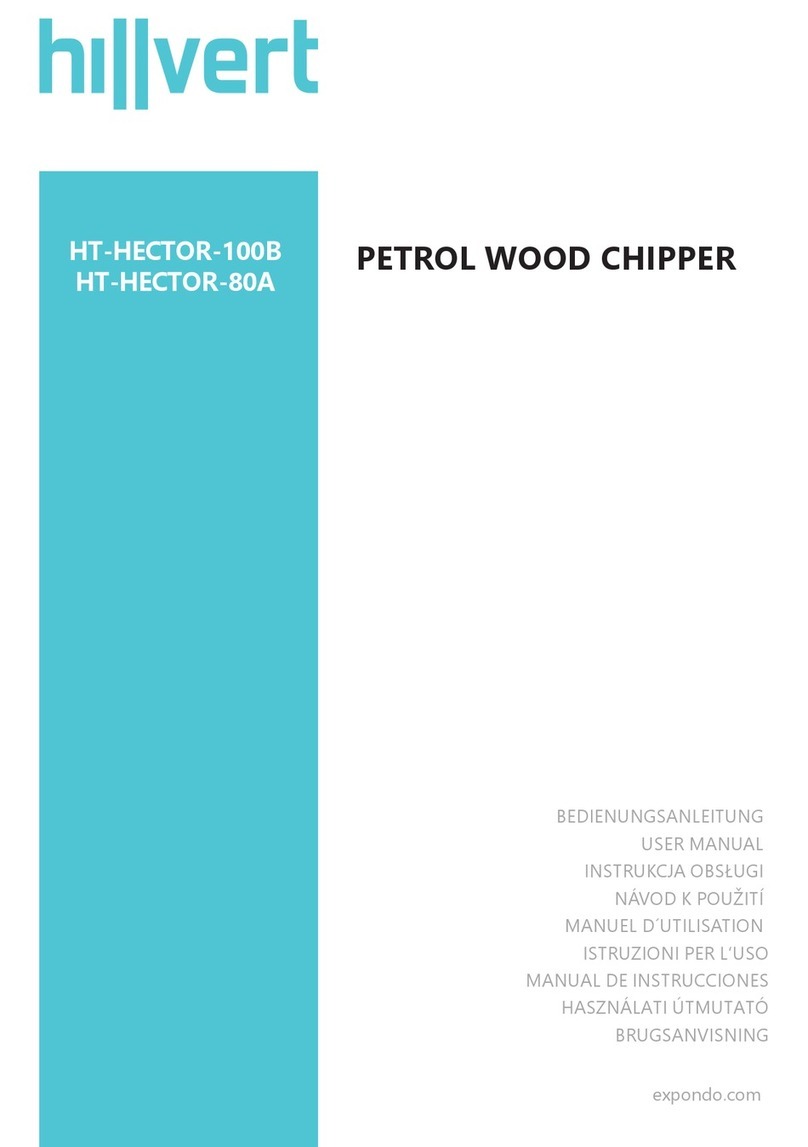
hillvert
hillvert HT-HECTOR-100B user manual

Jensen
Jensen A 518 Di operating instructions
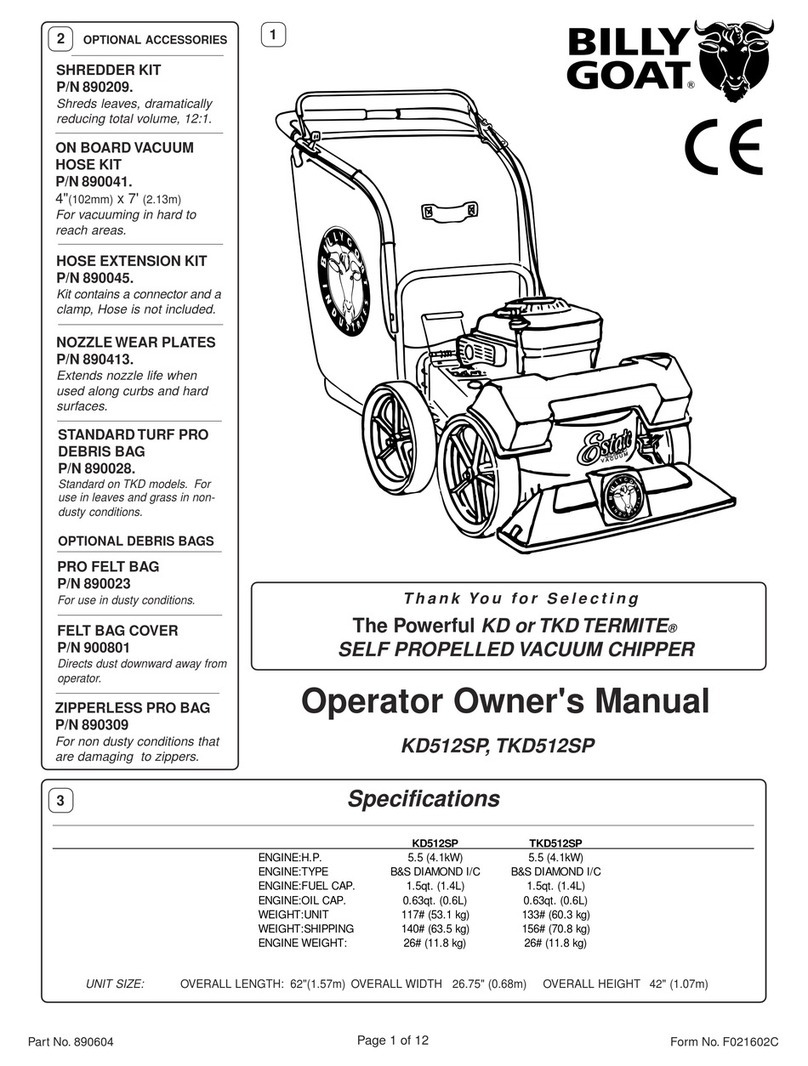
Billy Goat
Billy Goat Termite KD512SP Operator owner's manual

Craftsman
Craftsman 247.799891 owner's manual

red roo
red roo C80 Operation, Safety & Maintenance Instructions
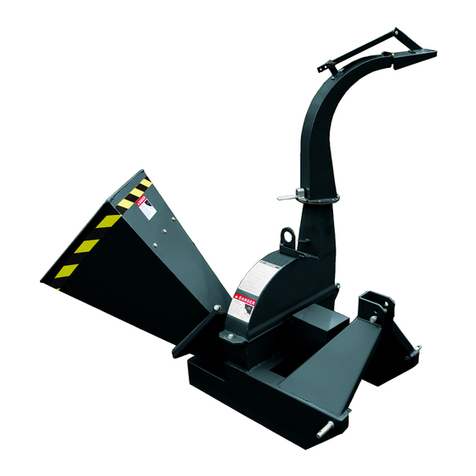
AGRI EASE
AGRI EASE BE-WC42G Operations & parts manual

